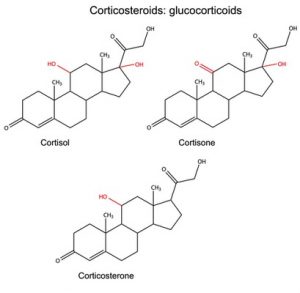
Cortisone, dexamethasone, hydrocortisone, methylprednisolone, prednisolone and prednisone are called corticosteroids or glucocorticoids. These drugs dampen an overactive immune reaction. They can soothe a bad poison ivy attack or a severe case of hives. Doctors and patients love these medications. They can reverse a life-threatening inflammatory reaction quite quickly. Despite their tremendous benefits, however, there are some very scary corticosteroid side effects that can occur even after only short-term use.
What’s the Difference Between Corticosteroids & “Steroids”?
Let’s clear one thing up immediately. Although some people refer to corticosteroids as “steroids,” they are totally different from the kinds of anabolic steroids athletes use to build muscles.
A steroid is a compound with a specific chemical structure. Without getting into the chemical weeds, here is a visual representation of the basic corticosteroid structure. What you can see, even if you have forgotten high school biochemistry, is a unique 4-ring structure.

The four rings are common to other steroids including the male hormone testosterone, the female hormones estrogen and progesterone as well as cholesterol. Even vitamin D is considered a steroid of sorts.
How Do Corticosteroids Calm An Overactive Immune System?
Think of inflammation a bit like an avalanche. A pebble falls over a cliff where it hits another pebble, which nudges a little rock that picks up momentum as it falls. Soon you have a bunch of rocks bouncing off each other on their way down the mountainside. Eventually, they turn into a full-blown landslide.
This cascade of events resembles the way inflammation builds in the body. The body has numerous inflammatory genes that make a variety of activator proteins and transcription factors (cytokines, chemokines, enzymes, etc.). These in turn trigger a cascade of events that lead to what we call the inflammatory reaction: redness, swelling, joint pain, flu-like symptoms, fever, headache, etc.
Corticosteroids switch off multiple inflammatory genes and chemical pathways (British Journal of Pharmacology, June, 2006). In other words, drugs like cortisone prevent the first few pebbles from precipitating a rock slide. If you can keep the body from amplifying the initial inflammatory signals, you can suppress the collateral destruction that would occur during a full-blown body avalanche.
Corticosteroid Side Effects Are Serious:
Most people know that cortisone-type drugs are powerful double-edged swords. On one hand, they relieve inflammatory reactions rapidly. That means corticosteroids can be beneficial against severe allergies, asthma, anaphylactic shock, inflammatory bowel disease, traumatic brain injury, rheumatoid arthritis and many other hard-to-treat conditions.
On the other hand, medications like dexamethasone, methylprednisolone and prednisone have a long list of serious side effects. They include fluid retention, hypertension, headache, increased susceptibility to infection, muscle weakness, diabetes, osteoporosis, tendon rupture, glaucoma, cataracts and ulcers. Psychological reactions such as anxiety, irritability, mood swings, insomnia, confusion and psychosis are disorienting at best and disabling at worst.
What is a Steroid Dosepak or Dose Pack Dosage?
Doctors assume that corticosteroid side effects are primarily linked to high-dose, long-term use. That is why short-term tapered “dosepaks” are so popular. Such dosing starts with a relatively high amount of corticosteroid and reduces it steadily over a week or two.
One “recipe” for sinusitis involves prednisone in the following dosages:
- Three days at 40 mg a day
- Three days at 30 mg a day
- Three days at 20 mg a day
- Three days at 10 mg a day
There are a great many variations on this theme. A survey of ear, nose and throat specialists revealed that doctors prescribe a median starting dose of prednisone of 60 mg (American Journal of Rhinology and Allergy, Jan 1, 2017). The dosage range, however, was from 4 to 80 mg. The length of treatment ranged from 2 days to 28 days. By the way, the Cochrane Database of Systematic Reviews (March 25, 2014) analyzed the available research and concluded that treating sinusitis with corticosteroids was ineffective. When combined with antibiotics, corticosteroids “…may be modestly beneficial for short-term relief of symptoms in acute sinusitis…”
Methylprednisolone (Medrol Dosepak)
One of the most commonly prescribed dose packs involves a potent corticosteroid called methylprednisolone. It is “stronger” than prednisone in that a smaller dose packs a bigger punch. Not all corticosteroids are created equal. Cortisone is the weakest and shortest acting. Prednisone is roughly five times more potent than cortisone.
Methylprednisolone Dose Pack recommendations for serious allergy symptoms:
- First day: 8 mg prior to breakfast; 4 mg after lunch; 4 mg after dinner; 8 mg before bed
- 2nd day: 4 mg prior to breakfast; 4 mg after lunch; 4 mg after dinner; 8 mg before bed
- 3rd day: 4 mg prior to breakfast; 4 mg after lunch; 4 mg after dinner; 4 mg before bed
- 4th day: 4 mg prior to breakfast; 4 mg after lunch; 4 mg before bed
- 5th day: 4 mg prior to breakfast; 4 mg before bed
- 6th day: 4 mg before breakfast
Some doctors continue to slowly taper the dose over the next week.
Short-Term Treatment CAN Cause Corticosteroid Side Effects:
Many physicians have been led to believe that a week or two of a drug like prednisone poses very little risk. That is why they are often quite reassuring to patients who may worry about corticosteroid side effects.
A new study reveals that even short-term steroid use can trigger dangerous side effects (BMJ, April 12, 2017). The researchers reviewed insurance-claims data for more than 1.5 million adults over two years, with special attention to those who took steroid pills for less than a month. They were more likely during that month and the five months following to suffer blood infections, blood clots and broken bones. These are serious complications, underscoring the need to make sure steroids are prescribed only when they are truly needed.
The Authors’ Conclusions:
“Oral corticosteroids are frequently prescribed for short term use in the US for a variety of common conditions and by numerous provider specialties. Over a three year period, approximately one in five American adults in a commercially insured plan used oral corticosteroids for less than 30 days. The short term use of these drugs was associated with increased rates of sepsis, venous thromboembolism, and fracture; even at relatively low doses.”
A Freak-Out Story From a Reader:
The study authors did not include data on patients who were already using inhaled steroids for asthma or chronic obstructive pulmonary disease (COPD). But adding oral steroids could cause difficulties, as it did for one reader. Here is her story:
“My doctor prescribed Medrol (methylprednisolone) for six days to treat bronchitis. I took it for the first two days and wasn’t getting much relief. I asked the doctor to call in an inhaler in the hope that it would help open up my lungs.
“Apparently the inhaler had more steroid in it and within a few minutes I started to feel really strange. I wanted to jump out of my own skin! Shortly after that I became manic.
“I don’t remember what followed, but my boyfriend says I flew into a rage, locked myself in my bedroom and refused to let him in. When I finally did, he said I was writing suicide notes and had several old bottles of pain meds out on the bathroom counter. He called 911 when I became very sleepy and disoriented.
“Thank God he did. It seems I had taken several pain pills and overdosed. I spent three days in the hospital on suicide watch and I don’t even remember doing anything. I will never take that stuff again!”
Psychiatric Corticosteroid Side Effects:
The psychiatric reactions to high-dose steroids are often under-appreciated, but they are not rare. Severe anxiety and insomnia, mood disorders including psychosis, delirium and even dementia are all possible (Psychiatry and Clinical Neurosciences, Oct. 2011).
Patients should be warned of this possibility before they begin taking corticosteroid drugs, whether short or long term. Prescribers also need to be aware of the potential for additive effects from various forms of steroid medicines, including inhalers as well as pills.
More Reader Stories:
This comes from “anonymous:”
“My 16-year-old family member recently had a psychotic reaction to prednisone. The drug was prescribed for a week to treat an asthma attack. His inhaler also had a steroid, which he used as needed.
“He ended up confined to a psychiatric ward for seven days. Upon release he had to be followed up with psychotherapy and anti-psychotic drugs for weeks. How can something like this happen if pediatric doctors are doing their job to follow up their patients?”
Frank in Vancouver, Canada, shares this:
“Prednisone worked well for controlling my Crohn’s flare up. As the dose was slowly reduced I experienced some rather concerning side affects. First was moodiness. Then bouts of anger.
“The worst was the extreme anxiety. At one point I didn’t leave the house for five days. Once I got down to 5 mg I started to get short of breath. After about twenty steps I would start gasping for air like a fish out of water. It was very scary.
“Once I stopped taking prednisone it took about a week to get back to normal. The dose was 40mg the first week and then 5mg less every week after until I reached 20 mg. Then less 2.5 mg a week until I finished. I will never use a steroid again.”
Kelly in New York had a psychotic break on prednisone:
“Ten mg of prednisone daily brought on a severe psychotic reaction. By the 3rd day I was totally paranoid and thought my Facebook friends were conspiring against me. Then I thought God was going to punish me; the police were coming to get me, and on and on and on.
“I ended up in a psych hospital for 3 weeks and was diagnosed, finally, with steroid-induced psychosis. They treated me with two different meds to pull me out of it. I will never take that med again, which sucks because I have ulcerative colitis. Death would be welcomed compared to the hell I endured while on prednisone.”
The Powerful Double-edged Swords:
Corticosteroids save lives! They help people who are having severe allergic symptoms, terrible asthma attacks or uncontrollable inflammatory reactions. But there are many scary corticosteroid side effects. Even short-term treatment can cause complications. Please make sure that your physician describes the pros and cons of steroid use in your particular situation. That way you can evaluate both the benefits and risks of such drugs.
If you found this article helpful please vote on this post at the top of the page.
You can also learn more about prednisone at this link:

